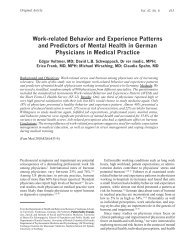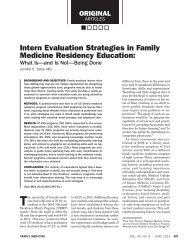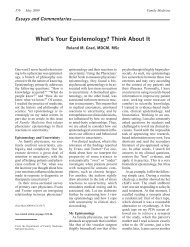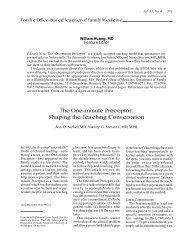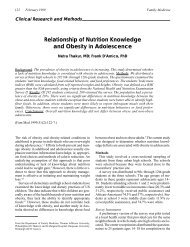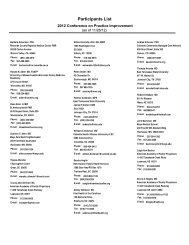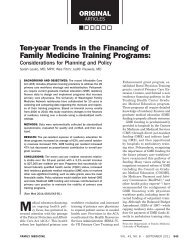Adult Inpatient Training for a Family Practice Residency: A ... - STFM
Adult Inpatient Training for a Family Practice Residency: A ... - STFM
Adult Inpatient Training for a Family Practice Residency: A ... - STFM
You also want an ePaper? Increase the reach of your titles
YUMPU automatically turns print PDFs into web optimized ePapers that Google loves.
Award-winning Papers From the AAFP 2001 Annual Scientific Assembly<br />
To our knowledge, however, there are no studies comparing<br />
the inpatient medicine training experiences of<br />
the same family practice residency in two different settings.<br />
Our current study compares first-year family practice<br />
residents’ inpatient experiences in a large urban<br />
university-based teaching hospital to their experiences<br />
in a small suburban community hospital. Our main<br />
objective was to determine if there were differences<br />
between the two settings in patient volume, diagnoses,<br />
and lengths of stay.<br />
Methods<br />
Human Subjects Protection<br />
This research project received exempt approval in<br />
May 2000 from Louisiana State University School of<br />
Medicine, New Orleans.<br />
Setting<br />
Our family practice residency uses two different hospitals<br />
<strong>for</strong> inpatient care. One is University Hospital (UH)<br />
in New Orleans, a 570-bed tertiary care teaching hospital<br />
located in the heart of New Orleans, a metropolitan<br />
city with a population of around 450,000. The other<br />
is Kenner Regional Medical Center (KRMC), a 90-bed<br />
community-based hospital located about 15 miles from<br />
New Orleans in the suburban city of Kenner that borders<br />
several rural counties.<br />
The residency program’s inpatient adult medicine<br />
teaching involves 2 months during the first year of residency.<br />
The first of these months is spent on UH’s internal<br />
medicine inpatient service. This service is staffed<br />
by one attending physician and one senior internal<br />
medicine resident, both of whom supervise three junior<br />
residents, one of whom is a family practice resident.<br />
The second month is spent on the inpatient adult<br />
family practice service at KRMC. This service is staffed<br />
by a family practice attending physician who supervises<br />
one upper-level and two first-year family practice<br />
residents.<br />
Data Collection<br />
Each day, both residency inpatient services routinely<br />
generate a “Patients’ Daily Census” report <strong>for</strong> purposes<br />
of monitoring the educational experience of residents.<br />
Each census <strong>for</strong>m contains patients’ identification numbers,<br />
age, date of admission and discharge, and primary<br />
and secondary diagnoses. The in<strong>for</strong>mation from these<br />
<strong>for</strong>ms was extracted <strong>for</strong> use as data in this study.<br />
Data Analysis<br />
Data were collected during March, May, July, August,<br />
October, and December 2000, <strong>for</strong> a total of 6<br />
months. At the end of 6 months, we computed descriptive<br />
statistics <strong>for</strong> key parameters describing the activity<br />
of the two clinical services. These parameters included<br />
number of monthly admissions, average length of hos-<br />
Vol. 34, No. 7<br />
519<br />
pital stay, patients’ age, and primary and secondary diagnoses.<br />
We then conducted a statistical analysis to<br />
determine if there were significant differences between<br />
the two training sites in any of these parameters. Differences<br />
between means were tested with two-sample<br />
independent t tests, and differences in proportions were<br />
tested with the chi-square statistic. All statistical computations<br />
were made with the SPSS ® <strong>for</strong> Windows.<br />
Results<br />
Number of Patients and Lengths of Stay<br />
The total number of patients seen over the 6-month<br />
study period at KRMC was 247 and at UH was 317.<br />
Each first-year resident was responsible <strong>for</strong> approximately<br />
21 patients per month at KRMC; at UH, each<br />
first-year resident saw approximately 18 patients per<br />
month—this difference was not statistically significant<br />
(P=.11). Significantly more patients were male at UH<br />
than at KRMC (55.2% versus 37.7%, P



